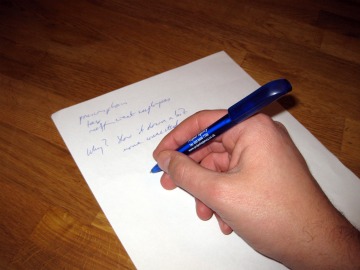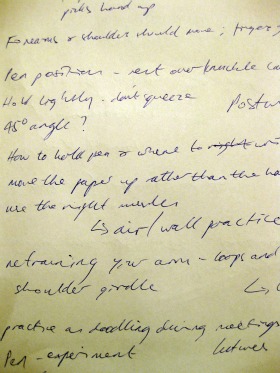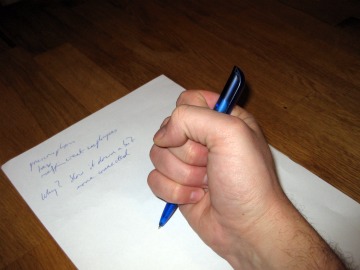Luckily, it is possible to reboot years of misaligned muscle memory and improve your handwriting – you just need time, determination, and the following common sense tips.
1. Decide why you want to improve your handwriting.
You need to know exactly what you hope to achieve, so you know what to focus on. Perhaps (like me) you want to write more legibly, so your notes don’t look like a spider has been dipped in poisonous ink and then violently convulsed itself to death across your page.Maybe there are a few letters you’ve never really been sure of (that would be you, joined-up s); or you want to impress that sexy graphologist you’re seeing by projecting the wonders of your personality through your loops and whorls.
It might be you want to write more fluently and efficiently, so your hand doesn’t cramp up after five minutes of scribbling; or that you believe it’s easier to manifest the poetic geometry of the universe through an actual pen than a computer keyboard.
There are as many good reasons to improve your handwriting as there are ways to write “spelling” in Old English. Regardless of your reasons, here’s how to do it.
2. Choose your weapon carefully.
English writer Edward Bulwer-Lytton famously wrote that “the pen is mightier than the sword.” Just as you wouldn’t go into battle armed with the rusty paper knife you found down the back of the armchair, you shouldn’t expect to produce beautiful handwriting using a half-chewed Biro encrusted in suspect fluff.It’s not necessary to buy a gold fountain pen with jewel-studded nib and ink distilled from a virgin squid, unless you happen to be a particularly sophisticated Bond villain. But you should experiment until you find a type of pen (or even pencil) that works for you.
A purist might tell you fountain pens are superior — presumably because it’s so hard to catch enough swans to make quills — but there are plenty of good ballpoints, roller-balls, and even felt tips out there.

Hand position: The top of the pen should rest on
or just in front of the base knuckle.
Writing by hand shouldn’t be like a game of Mercy with your pen, so look for one that’s comfortable to hold, and where the ink flows smoothly without your having to push too hard on the paper. or just in front of the base knuckle.
Also, try pens with different sized nibs or balls to find a line thickness that pleases you, and experiment with different colors. But take care — it doesn’t matter how beautiful your script, it will still look horrendous if rendered in a bilious green ink.
3. Get a grip.
Although your pen does have a pointy bit, it’s not actually a mighty sword, so you needn’t hold it like one. Your grip should be light yet supportive, and there should be no undue tension in your hand position. Don’t squeeze — your pen is no more a tube of toothpaste than it is a weapon, and the ink will flow of its own accord.It doesn’t really matter which fingers you use to hold the pen, as long as it feels comfortable and balanced. But it’s best for the top (the non-business end) to rest on or just in front of the base knuckle of your index finger, rather than in the gully formed between index finger and thumb.
4. Sort your posture.
You need to sit up straight yet relaxed, with your non-writing fingers gently curled under your hand, and your hand position resting lightly on the table. Some people recommend having your writing surface at a 45-degree angle, which could be tricky unless you have a high-tech bat-desk, or are trying to save time by writing directly onto your laptop screen.Clear some space, because you need room to move your arm when writing properly. You can’t produce elegant, free-flowing script if you’re hunched up over the only corner of your desk not littered with empty coffee cups, half-eaten sandwiches, and rogue power cables. There was a reason people had writing desks back in the days of yore.
Finally, once you have a comfortable writing position, don’t screw it up by altering your alignment. When it becomes awkward to move your hand position down the page to write the next line, try moving the paper up instead of your hand down. Unleashing a typewriter bing is optional.
5. Put your shoulder into it.

This is how much my writing sucks.
Having the right pen, correct grip, and good posture is worth nothing if you’re drawing the letters with your fingers. Strange as it sounds, you should not be using your wrist and fingers to write — that leads to cramped, stilted writing, as well as fatigue.Rather, your fingers should hold the pen in place and act as a guide, and all the movement should come from the shoulder girdle. This is one of the main muscle groups you use to raise your arm and rotate it in a big circle, like Popeye powering up for a thunder punch.
In other words, your shoulder and forearm move as you write, but your wrist and fingers don’t. This helps you write in a more fluid, efficient style. It takes practice, and feels weird at first, but these muscle groups don’t get tired as quickly as your wrist and fingers.
6. Swap your air guitar for an air pen.
To practice using your shoulder muscles to write, hold your arm in front of you, elbow bent, and write big letters in the air. Concentrate on moving from the shoulder and holding your forearm, wrist, and fingers steady. Muscles from your shoulder, arm, chest, and back should be working. These are the muscle groups you want to use when writing with pen and paper.Once you are comfortable doing this — which mostly means coming to terms with how ridiculous you look — try making smaller and smaller air letters. You can also try tracing the shapes of letters onto a wall with your finger, or writing on a blackboard or whiteboard.
Writing on a vertical surface means you automatically use the correct muscle groups. Resist the temptation to get close and rest your hand on the wall, because this means you are writing with your fingers again.
7. Bust out some shapes.
Once you’re confident with the muscle groups needed to write in thin air, it’s time to fire it up to 11 and break out the pen and paper. This article suggests you start out writing large X’s, /’s, O’s, swirls, and loops. Really concentrate on moving from the shoulder, holding your wrist steady, and using your fingers just as a guide. Focus on producing nice, smooth shapes, and use lined paper to help with consistent size and spacing.
Probably best not to hold your pen with this hand position.
As you get better, make your shapes smaller and smaller. Begin introducing letters — again, start out big and bold, and gradually get smaller. When you’re ready to go crazy, bust out some words, sentences, and even whole paragraphs.Asking an adult to practice writing big letters might seem as pointless as Mr. Miyagi telling Daniel-san to paint his fence. But you aren’t just learning new muscle memory, you’re trying to unlearn bad habits.
8. Practice whenever you can.
Take every opportunity to write longhand instead of on a keyboard. If you’re a writer, or need to write a report or proposal, consider doing your first draft using pen and paper. You can polish and edit as you type it up. Write out old-skool to-do lists rather than using a computer program. Start maintaining a journal. If you’re stuck in a boring meeting, presentation, or lecture, practice your handwriting strokes instead of doodling whirlwinds and boxes.Practice your handwriting for a few minutes each day, and you should start to see improvements quite quickly. Try making up motivational sentences that use letters in different ways.


No comments:
Post a Comment
Add my pin for BBM updates pin:23409596